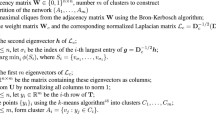Abstract
With the rapidly growing evidence that various systems in nature and society can be modeled as complex networks, community detection in networks becomes a hot research topic in physics, sociology, computer society, etc. Although this investigation of community structures has motivated many diverse algorithms, most of them are unsuitable when dealing with large networks due to their computational cost. In this paper, we present a faster algorithm ComTector, which is more efficient for the community detection in large complex networks based on the nature of overlapping cliques. This algorithm does not require any priori knowledge about the number or the original division of the communities. With respect to practical applications, ComTector is challenging with five different types of networks including the classic Zachary Karate Club, Scientific Collaboration Network, South Florida FreeWord Association Network, Urban Traffic Network, North America Power Grid and the Telecommunication Call Network. Experimental results show that our algorithm can discover meaningful communities that meet both the objective basis and our intuitions.
Similar content being viewed by others
References
Watts D J, Strogatz S H. Collective dynamics of “small-world” networks. Nature, 393(6684): 440–442.
Watts D J. Small Worlds: The Dynamics of Networks Between Order and Randomness. Levin S A, Strogatz S H (eds.), Princeton: Princeton University Press, 1999.
Boccaletti S, Latora V, Moreno Y. Complex networks: Structure and dynamics. Physics Reports, 424(4/5): 175–308.
Newman M E J. The structure and function of complex networks. SIAM Review, 45(2): 167–256.
Wasserman S, Faust K. Social Network Analysis. Cambridge: Cambridge University Press, 1994.
Scott J. Social Network Analysis: A Handbook. London: Sage Publications, 2002.
Milo R, Itzkovitz S et al. Network motifs: Simple building blocks of complex networks. Science, 298(5594): 824–827.
Newman M E J. Modularity and community structure in networks. PNAS, 103(23): 8577.
Girvan M, Newman M E J. Community structure in social and biological networks. PNAS, 99(12): 7821–7826.
Duch J, Arenas A. Community detection in complex networks using extremal optimization. Physical Review E, 72(2): 027104.
Palla G, Dernyi I, Farkas I. Uncovering the overlapping community structure of complex network in nature and society. Nature, 435(7043): 814–818.
Fiedler M. Algebraic connectivity of graphs. Czechoslovak Mathematical Journal, 23(98): 298–305.
Pothen A, Simon H, Liou K-P. Partitioning sparse matrices with eigenvectors of graphs. SIAM J Matrix Anal App., 11(33): 430–452.
Kernighan B W, Lin S. A efficient heuristic procedure for partitioning graphs. Bell System Technical Journal, 49(2): 291–307.
Newman M E J. Detecting community structure in networks. Eur. Phys. J. B, 38(2): 321–330.
Bron C, Kerbosch J. Finding all cliques of an undirected graph. Communications of the ACM , 16(9): 575–577.
Du N, Wu B, Wang B et al. A parallel algorithm for enumerating all maximal cliques in complex networks. In Proc. The 6th ICDM2006 Workshop, Hong Kong, 2006, pp.320–324.
Wu B, Pei X et al. A parallel algorithm for enumerating all the maximal k-plexes. In Proc. PAKDD07 Workshops, Nanjing, 2007, pp.476–483.
Abello J, Resende M G C, Sudarsky S et al. Massive quasiclique detection. In Proc. the 5th Latin American Symposium on Theoretical Informatics, Mexico, 2002, pp.598–612.
Pei J, Jiang D X, Zhang A D et al. On mining cross-graph quasi-cliques. In Proc. The 12th ACM SIGKDD, Philadelphia, 2006, pp.228–237.
Zeng Z, Wang J, Karypis G et al. Coherent closed quasiclique discovery from large dense graph databases. In Proc. The 12th ACM SIGKDD, Philadelphia, 2006, pp.797–802.
Han J W, Kamber M. Data Mining: Concepts and Techniques. 2nd Edition, Morgan Kaufmann Publishers, 2006.
Luca Donetti, Miguel A. Munoz detecting network communities: A new systematic and efficient algorithm. Electric Journal of Statistical Mechanics, doi10.1088/1742-5468/2004/10/P10012, http://www.iop.org/EJ/abstract/1742-5468/2004/10/P10012.
Girvan M, Newman M E J. Finding and evaluating community structure in networks. Physical Review E, 69(2): 026113.
Radicchi F, Castellano C, Cecconi F, Loreto V, Parisi D. Defining and identifying communities in networks. PNAS, 101(9): 2658–2663.
Clauset A, Newman M E J, Moore C. Finding community structure in very large networks. Physical Review E, 70(6): 066111.
Pons P, Latapy M. Computing communities in large networks using random walks. In Proc. ISCIS2005, Istanbul, 2005, pp.284–293.
Clauset A. Finding local community structure in networks. Physical Review E, 72(2): 026132.
Yang B, Liu D Y. Force-based incremental algorithm for mining community structure in dynamic network. Journal of Computer Science and Technology, 21(3): 393–400.
Gunes I, Bingol H. Community detection in complex networks using agents. Cornell University Library e-prints, arXiv:cs/0610129v1, http://arxiv.org/abs/cs/0610129v1.
Fortunato S, Barthelemy M. Resolution limit in community detection. PNAS, 2007, 104(1): 36–41.
Author information
Authors and Affiliations
Corresponding author
Additional information
This work is supported by the National Natural Science Foundation of China under Grant No. 60402011, and the National Science and Technology Support Program of China under Grant No.2006BAH03B05.
Electronic supplementary material
Below is the link to the electronic supplementary material.
Rights and permissions
About this article
Cite this article
Du, N., Wang, B. & Wu, B. Community Detection in Complex Networks. J. Comput. Sci. Technol. 23, 672–683 (2008). https://doi.org/10.1007/s11390-008-9163-6
Received:
Revised:
Published:
Issue Date:
DOI: https://doi.org/10.1007/s11390-008-9163-6




